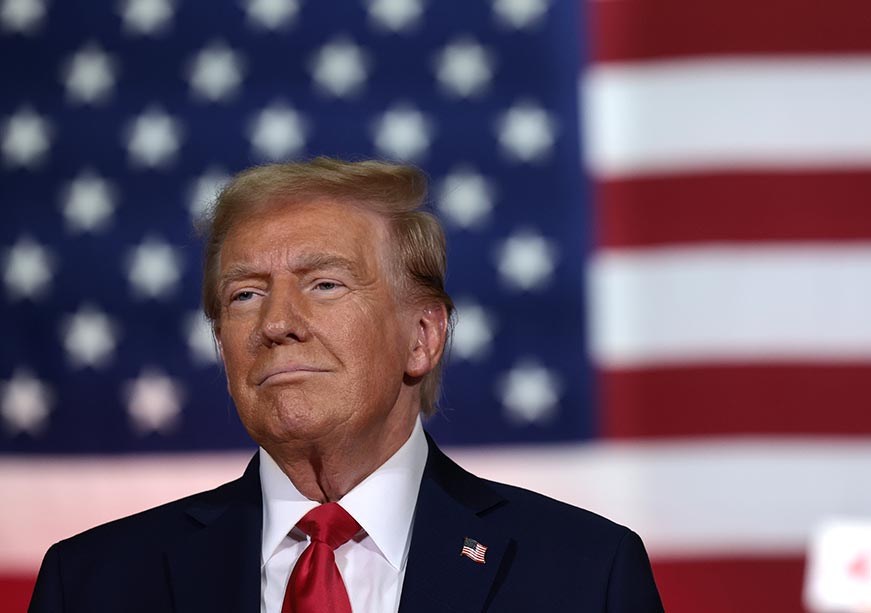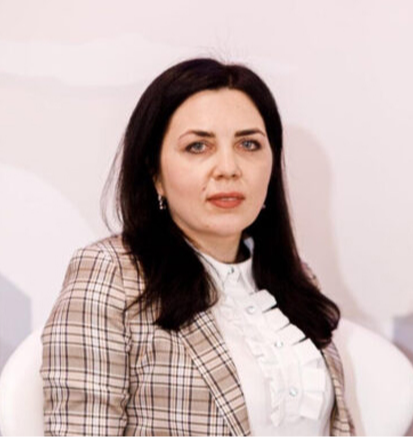-
CENTRES
Progammes & Centres
Location
Donald Trump’s re-election could bring the Russia-Ukraine war to a swift end, but the terms of peace might not be in Ukraine’s favour

Image Source: Getty
Ukraine has passed the thousandth day of full-scale war. The country has managed to stay alive in the largest conflict since World War II, despite Russia's significant advantage in human and material resources, and the unreliable military assistance of Ukraine’s Western allies.
Even after 1,000 days of conflict, uncertainty continues to define the Ukraine-Russia war. Following the failure of his initial blitzkrieg strategy, President Putin has shifted to a strategy of prolonged conflict, banking on the West's wavering resolve to support Ukraine “as long as it takes.”. According to former Ukrainian Foreign Minister Dmytro Kuleba, the biggest problem Ukraine has faced is the “dominance of the concept of [avoiding] escalation” in the decision-making processes of Kyiv's Western partners. This cautious approach has led to delays in the supply of Western weapons and significant restrictions on the use of these weapons, significantly worsening the Ukrainian army’s position on the battlefield.
The containment strategy chosen by President Biden has failed to weaken the Russian economy and isolate Moscow enough to force Putin to abandon this war. Moreover, Russia has been able to rebuild its economy and its military-industrial complex, still receiving Western components for weapons production via intermediary third countries.
Russian drones and missile wreckage are regularly found in Romania, Moldova, and Poland, but NATO has not yet dared to shoot down Russian air targets even over the territory of its member states.
President Biden may have avoided the direct clash between the North Atlantic Treaty Organization (NATO) and Russia, but this has not removed the threat to Ukraine's neighbours. Russian drones and missile wreckage are regularly found in Romania, Moldova, and Poland, but NATO has not yet dared to shoot down Russian air targets even over the territory of its member states. This indicates the West's inability to respond appropriately to security challenges and has only deepened relations between Russia, Iran, North Korea, and China. This was confirmed by the participation of North Korean troops in the war.
The war is causing heavy civilian casualties and significant damage to Ukraine's economy and energy sector. It is paradoxical that recently the world has been increasingly hearing about “war fatigue”, not from Ukrainians exhausted by the war, but from countries that have not been directly affected by the war.
This general “fatigue” has resulted in the international community's willingness to sacrifice parts of Ukraine's territories to appease Putin. “Peace in exchange for territory” has become a deceptive strategy to end the Russia-Ukraine conflict—a process actively promoted on international platforms and in the global information space. In fact, almost three years into a full-scale war, Ukraine has once again returned to the issue of peace through concessions, as it did after the occupation of Crimea and Donbas in 2014.
Donald Trump’s victory significantly raises the prospects of a freeze in the Russia-Ukraine war. During his election campaign, he repeatedly said that he could end the Russia-Ukraine war in 24 hours. However, for Ukraine, the critical question remains the terms on which such a truce would be established. Trump’s comments raise concern in Kyiv as he has threatened to cut off financial support and the supply of weapons to Ukraine as a way to bring both parties to the negotiating table.
While the Biden administration stated that only Ukraine should decide where, when, and how to start negotiations, Trump does not hide the fact that he will initiate the negotiation process. The biggest risk for Ukraine in these circumstances is the newly elected American president's desire to broker a ‘quick deal’. Hasty agreements could result not only in significant concessions for Ukraine but also a fragile ceasefire that could quickly escalate into a new clash.
The biggest risk for Ukraine in these circumstances is the newly elected American president's desire to broker a ‘quick deal’.
Donald Trump has not yet unveiled his peace plan, but his team's ideas point to the possibility of freezing the war, postponing Ukraine's accession to NATO for at least 20 years and creating a demilitarised zone along the front line, all while excluding the involvement of American financial and human resources in the peacekeeping process. The Trump administration’s desire to transfer responsibility for the situation in Ukraine onto Europeans only strengthens Moscow's confidence that the situation is developing most favourably.
Recently, Moscow has been escalating significantly and is trying to seize as much Ukrainian territory as possible, driving Ukrainian troops out of Russia's Kursk region before the United States (US) inaugurates its new president. In response to the Ukrainian army's permission to use Western long-range weapons to strike into Russian territory, the Kremlin has approved an updated nuclear doctrine. One of the conditions for the use of nuclear weapons is if ballistic missiles are launched against Russia.
A high-stakes game requires strong positions from all parties. Russia is trying to gain a dominant negotiating position by intensifying missile and drone attacks against infrastructure, energy facilities, and civilians throughout Ukraine. The recent shelling of Ukrainian cities has not stopped day or night. Kyiv alone has suffered 10 combined aerial assaults in 2024, with Russia deploying 1,250 aerial weapons.
Putin's strategic calculation is not to reach agreements on ending the war and legalising 20 percent of occupied Ukrainian territory; rather, he seeks to gain control over all of Ukraine. The Russian president has repeatedly stated that Moscow is ready to negotiate with Ukraine, but based on emerging “realities” (meaning that Russia retains territorial gains) and the agreements reached in Istanbul. On 15 April 2022, representatives of Ukraine and Russia preliminarily agreed to certain conditions for ending the war, which required Kyiv to agree to neutrality, significantly limit the size of its army (number of troops, aircraft, weapons and equipment), and enact several bans on joint exercises with other countries, as well as bans on the admission of foreign troops and weapons into its territory. As for Russia's commitments, Moscow promised not to attack Ukraine again and agreed to comprehensive security guarantees with the US, Britain, France, and China. Given the complete failure of the Budapest Memorandum, which did not protect Ukraine from military aggression by one of the signatories, this agreement looks like an attempt to limit Ukraine's sovereignty in exchange for dubious security guarantees.
Russia is trying to gain a dominant negotiating position by intensifying missile and drone attacks against infrastructure, energy facilities, and civilians throughout Ukraine.
Putin may agree to negotiate with the new American president to break his diplomatic isolation from the West. The incentives that Trump will give him to end the war remain to be seen. Moreover, whether Donald Trump is ready to respond to all of Vladimir Putin's terms, which would automatically mean the surrender of Ukraine's interests and a weakening of the US position, remains uncertain.
There are doubts about Trump taking into account all the risks and obstacles when he prematurely claimed to resolve the Russian-Ukrainian conflict. The ability to pull off a “big deal” in international relations using business templates for negotiations did not yield significant results with the Democratic People's Republic of Korea (DPRK), Iran, and China during his last presidential term. It is quite possible that it might not work with Russia either.
In this situation, Ukraine can hardly hope to liberate the occupied territories and return to 1991 borders. While the Ukrainian government officially emphasises that it will not make any territorial concessions, President Zelenskyy said in a recent speech to parliament that “Ukraine may have to outlast someone in Moscow to achieve all its goals”. This refers to the diplomatic settlement of territorial issues after a change in Russia’s political leadership in the future. For now, Ukraine's priority should be to strengthen its negotiating position with the support of the US and to obtain effective security guarantees. According to Volodymyr Zelenskyy, “This is a losing status for Ukraine at the entrance. In a weak position, there is nothing to do in these negotiations.”
Taking into account the change in political leadership in the US, the Ukrainian government has to fulfil several important tasks.
First, matching Donald Trump's “transactional’ approach” to international relations, the Ukrainian government must convince Trump that continuing to support Kyiv is beneficial for the US. This is not only about Washington's geopolitical status, which could be damaged by making concessions to Putin and the threat of a renewed war; Ukraine can become an important contributor to the economic and security spheres of the West. In his Victory Plan, Volodymyr Zelenskyy proposed that Western companies can engage in the joint protection and extraction of important natural resources, including rare-earth metals. He also put forth the possibility of replacing certain US army contingents stationed in Europe with Ukrainian units after the war.
Ukraine needs to develop an algorithm for long-term support by European countries, which will be forced to take greater responsibility for security in the European continent and increase financial spending on defence.
Second, Ukraine needs to develop an algorithm for long-term support by European countries, which will be forced to take greater responsibility for security in the European continent and increase financial spending on defence. Since the beginning of the full-scale invasion, the EU has been providing significant political, economic, financial, and humanitarian assistance to Kyiv. Supporting Ukraine is in the interests of European countries because, according to EU High Representative Josep Borrell, “The ten-year security agreement, which the EU signed with Ukraine in June, remains valid. We supported and will continue to support Ukraine. And we will do it not because we are very friendly and very generous - but because it is in our interests! Ukraine's security is part of our security.” Many European countries allocate a large portion of their military budgets to support Ukraine. Another important trend has been the participation of European companies in joint arms production, investment in the Ukrainian military sector, and the localisation of Western arms production plants in Ukraine.
Third, Ukraine must mobilise its internal resources. On 18 November, the President of Ukraine presented a 10-point conceptual document, the Internal Resilience Plan, which envisages consolidating efforts and resources for long-term struggle. This plan covers various areas, including maintaining unity, strengthening the army and defence industry, changing approaches at the front, protecting energy and improving the quality of human capital. In the context of a long-term war, such a strategy is necessary to adapt the state's governance and society to new realities.
President Zelenskyy has stated that the decisive moments of this war will take place next year. Trump's desire to end the war quickly, on one hand, accelerates the prospect of peace for Ukraine. On the other hand, it reduces the probability of a just and lasting peace, which Ukraine has long advocated for. In the current situation, Vladimir Putin sees favourable conditions for achieving his goals and has set terms that could lead not only to Ukraine's capitulation but also to the loss of its statehood. However, given Trump’s unpredictability, forecasting an end to the war remains highly uncertain.
Nataliya Butyrska is a Senior Fellow of the New Europe Centre from Kyiv, Ukraine.
The views expressed above belong to the author(s). ORF research and analyses now available on Telegram! Click here to access our curated content — blogs, longforms and interviews.

Nataliya Butyrska is a freelance expert on International Relations from Kyiv, Ukraine. ...
Read More +